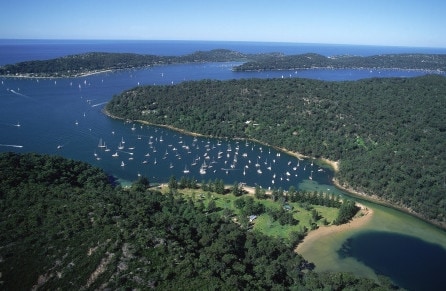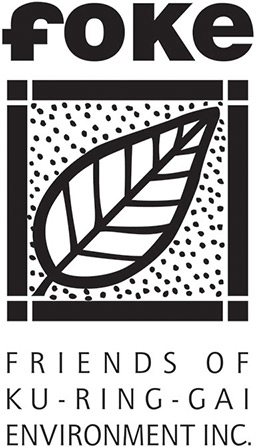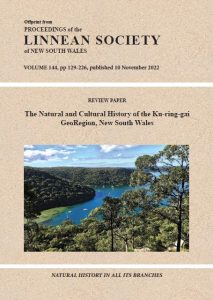FOKE
Ku-ring-gai GeoRegion
Ku-ring-gai GeoRegion
Steering Committee member Bob Conroy’s Presentation to the National Parks Association (NPA) Northern Beaches Branch on 14th February 2024 can be seen here Kuring-gai Geoheritage .
First Ku-ring-gai GeoRegion geotrail signage installed at Browns Field, Fox Valley.
For more information see our latest post here.
Ku-ring-gai GeoRegion Study a major step forward
As highlighted previously, in 2018 FOKE initiated a project to add extra protections to, and increase awareness of, Ku-ring-gai’s natural heritage focusing originally on Ku-ring-gai Chase National Park.
This has since developed into a much broader area as we have advanced the proposal of a GeoRegion with Ku-ring-gai Chase as its centre, now extending along Berowra Valley, from the Hawksbury River to northern Lane Cove National Park, east to the coast from Barrenjoey to Dee Why.
This large area, of approximately 44,000 ha, across northern Sydney showcases exceptional characteristics, with over 50 national and internationally significant geological environments of the Triassic sandstone landscapes of the Sydney Basin, unique and rare flora and fauna, and a density of Aboriginal sites that reflects the length of habitation in this area, with 1,424 sites currently recorded. A short video can be seen here.
The proposal has been endorsed in principle by the Geological Survey of NSW and is supported by three local Councils (Hornsby, Ku-ring-gai, and Northern Beaches) and the National Parks and Wildlife Service, and local MPs. ‘ Geotrails’ identifying a network of key sites are being developed with appropriate interpretation, with the first of these expected to open in 2023.
The Ku-ring-gai GeoRegion is also referenced and recognised in the Australian Government’s THRIVE 2030 Visitor Economy Strategy as having the potential to be one of three GeoRegions to be nominated as an Aspiring UNESCO Global Geopark for Australia.
On 17th November 2022, the GeoRegion Steering Committee presented at the Linnean Society Sydney Symposium, highlighting the outstanding Natural and Cultural History of the Ku-ring-gai GeoRegion. A major co-authored technical study underpinned the presentations and is published in the current Linnean Society Proceedings journal.
The project Steering Committee believes that the contents of this study will form a solid basis for any proposed nomination submitted to UNESCO assessors. The link to the paper is here. If you would like to purchase the printed book, this is available through the NPWS Information Centre at Bobbin Head. Please contact Michelle Holder, Supervisor Visitor Centre, NSW National Parks and Wildlife Service Tel: (02) 9472 8948 or Email: Michelle.Holder@environment.nsw.gov.au
It remains FOKE’s focus to ensure that our natural and cultural heritage is valued by the next generation as well as our growing number of residents.
Only when areas are valued will communities fight for their conservation and protection
UNESCO World Heritage listing of Ku-ring-gai Chase National Park (KCNP).
In October 2018 Friends of Ku-ring-gai Environment (FOKE) resolved to commence a campaign to call for the UNESCO World Heritage listing of Ku-ring-gai Chase National Park (KCNP).
This has now developed into a proposal for the eventual listing of a potential Aspiring UNESCO Global Geopark resulting from the significance of the GeoRegion’s outstanding geological features. The initial focus is the development of a designated ‘GeoRegion’, with geotrail development signage and promotion of its significance. To date we have received strong support from key stakeholders within the three Councils, local politicians and several State Government Ministers, and the NSW Parks and Wildlife Service.
FOKE originally initiated this project with the objective of making a positive contribution to conservation based in and around Ku-ring-gai Chase National Park, by seeking recognition of the very significant natural and cultural heritage values. This is exemplified by a wide range of geologically significant features (i.e. geosites) that exist in this area, added to its strong biodiversity recognition.

Having conferred with a range of experts on the geology, geomorphology, natural and cultural heritage values of Ku-ring-Gai Chase National Park, it was decided to extend the area of geoheritage significance to embrace areas in the proximity of Ku-ring-gai Chase National Park.
Natural and Cultural Heritage of the ‘Ku-ring-gai GeoRegion’
The special geosites chosen to profile exist in a broad area (with the working project name of ‘Ku-ring-gai’) and previously classified in 2002 as forming part of the Hornsby Plateau Landscape which includes:
- Cliffs, beaches, and lagoons from Long Reef to Barrenjoey.
- Ku-ring-gai Chase National Park.
- Muogamarra Nature Reserve.
- Northern Garigal National Park.
- Berowra Valley National Park.
This outstanding ‘GeoRegion’ contains:
- Numerous geological sites, including several sites of international significance. Currently more than 45 key geosites have been identified across the area.
- Extensive rare and threatened flora and fauna
- Ku-ring-gai Chase National Park was registered on the National Heritage List in 2006, with the following assessment:
‘Summary of Significance: Ku-ring-gai Chase National Park and Long Island, Lion Island, and Spectacle Island Nature Reserves contain an exceptional representation of the Sydney region biota, a region which is recognised as a nationally outstanding centre of biodiversity. The place contains a complex pattern of 24 plant communities, including heathland, woodland, open forest, swamps and warm temperate rainforest, with a high native plant species richness of over 1000 species and an outstanding diversity of bird and other animal species. The place is an outstanding example of a centre of biodiversity.’
- The area provides a vast array of Aboriginal heritage sites including rock engravings, cave art sites, grinding grooves, shell middens, occupational deposits, stone arrangements and burials. It is one of Australia’s most dense areas for Aboriginal sites. Over 570 sites recorded, some with multiple site traits.
Geological Heritage
Of international geological significance:
- The proposed ‘Ku-ring-gai’ GeoRegion reveals the best exposed geological section of early to mid-Triassic period (240 million years ago) sedimentary rocks in the Sydney Basin.
- The sediments were deposited in Gondwana adjacent to a high latitude coast under a cold climate in fluvial, lacustrine, and shallow marine environments. Various rock units contain a diversity of fossils that inform us of past environments over nearly 50 million years.
- The GeoRegion includes eight volcanic diatremes (pipes) and associated dykes with the Hornsby diatreme having perhaps the best known exposed geological section in NSW, if not in all Australia.
Of particular interest, the geomorphology comprising deep valleys, extensive estuaries, pocket beaches, headland cliffs and coastal lagoons was formed by post-glacial sea level rise.
Dr John Martyn, a member of our Steering Committee, has produced a 135 page book highlighting the importance of the features of the area. A sample of this book is available here.


